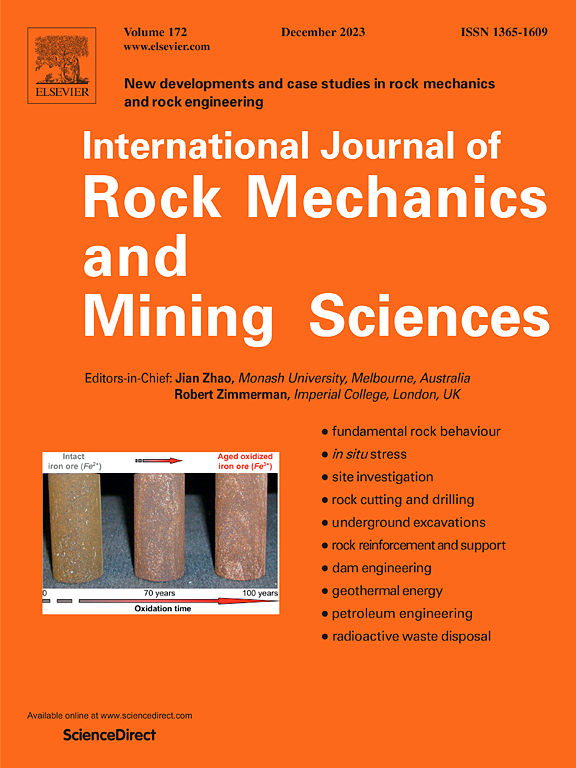The hydromechanical coupled numerical method in pseudo-3D axisymmetric domain with cracks extension and coalescence applies to the decompression failure problem
IF 7
1区 工程技术
Q1 ENGINEERING, GEOLOGICAL
International Journal of Rock Mechanics and Mining Sciences
Pub Date : 2024-10-24
DOI:10.1016/j.ijrmms.2024.105945
引用次数: 0
Abstract
The stress-strain state of the saturated porous media determines the behavior of fracturing, which defines the efficiency of developing tight oil, shale, coalbed, and thermal energy fields. Therefore, reliable hydromechanical coupled simulations with destruction reconstruction are critical.
The proposed innovative simulator has a strong interrelation between fluid flow and rock deformation of porous media and realizes a fully coupled pseudo-transient numerical method by high-performance computing (HPC) tools. To increase the detail of the results in the problem, a finite difference numerical algorithm was implemented in the axisymmetric cylindrical domain, which reduces from three to two dimensions without loss of precision. Highly efficient parallelization using CUDA on the GPU computes meshes of up to one billion cells, allowing the simulation of a total core sample to sub-micrometer resolution in an appropriate time. The algorithm has been validated to find the exact solution to the cylinder problem. The proposed model accounts for cracks propagation with their coalescence within a single computational static grid, which keeps timing close to the continuous model.
This comprehensive implementation enables solving industrial problems, such as modeling core sample damage during rapid decompression. High-resolution simulations help reconstruct fracture propagation, analyze the initial stress state, and identify critical damage factors. The comparison with the exact solution to the cylinder problem confirmed the reliability of the algorithm. The calculation results show a strong dependence of decompression failure on the coalescence and elongation of cracks, influenced significantly by the rock's cohesion. Microcracks length and distribution play a decisive role in the decompressive destruction behavior of the rock sample. For the first time, the simulations demonstrated the decompressive destruction of a core sample during an uncontrolled, rapid core retrieval operation.
伪三维轴对称域中的水力机械耦合数值方法(含裂缝扩展和凝聚)适用于减压失效问题
饱和多孔介质的应力应变状态决定了压裂行为,而压裂行为决定了致密油、页岩、煤层和热能领域的开发效率。所提出的创新模拟器在多孔介质的流体流动和岩石变形之间具有很强的关联性,并通过高性能计算(HPC)工具实现了完全耦合的伪瞬态数值方法。为了增加问题结果的细节,在轴对称圆柱域中实施了有限差分数值算法,在不损失精度的情况下从三维减少到二维。利用 GPU 上的 CUDA 进行高效并行化,可计算多达 10 亿个单元的网格,从而能够在适当的时间内模拟亚微米分辨率的总核心样本。经过验证,该算法可以找到圆柱体问题的精确解。所提出的模型在单个计算静态网格内考虑了裂纹的传播和凝聚,使时间与连续模型接近。这种全面的实施方法可以解决工业问题,如模拟快速减压过程中的岩心样品损伤。高分辨率模拟有助于重建断裂扩展、分析初始应力状态和识别关键损伤因素。通过与圆柱体问题的精确解进行比较,证实了该算法的可靠性。计算结果显示,减压破坏与裂缝的凝聚和伸长有很大关系,受岩石内聚力的影响很大。微裂缝的长度和分布对岩样的减压破坏行为起着决定性作用。模拟首次证明了岩心样本在不受控制的快速岩心取回过程中的减压破坏。
本文章由计算机程序翻译,如有差异,请以英文原文为准。
求助全文
约1分钟内获得全文
求助全文
来源期刊
CiteScore
14.00
自引率
5.60%
发文量
196
审稿时长
18 weeks
期刊介绍:
The International Journal of Rock Mechanics and Mining Sciences focuses on original research, new developments, site measurements, and case studies within the fields of rock mechanics and rock engineering. Serving as an international platform, it showcases high-quality papers addressing rock mechanics and the application of its principles and techniques in mining and civil engineering projects situated on or within rock masses. These projects encompass a wide range, including slopes, open-pit mines, quarries, shafts, tunnels, caverns, underground mines, metro systems, dams, hydro-electric stations, geothermal energy, petroleum engineering, and radioactive waste disposal. The journal welcomes submissions on various topics, with particular interest in theoretical advancements, analytical and numerical methods, rock testing, site investigation, and case studies.

 求助内容:
求助内容: 应助结果提醒方式:
应助结果提醒方式:


